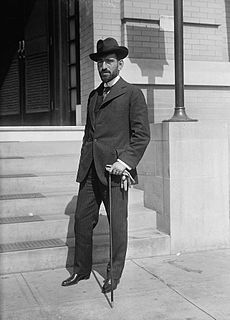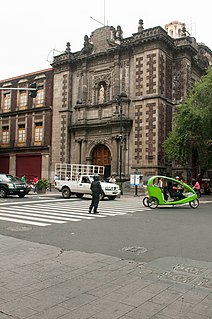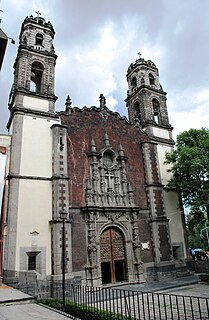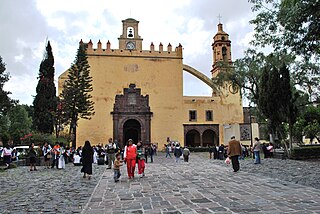

The Church and Convent of San Francisco is located at the western end of Madero Street in the historic center of Mexico City, near the Torre Latinoamericana and is all that remains of the church and monastery complex. This complex was the headquarters of the first twelve Franciscan friars headed by Martín de Valencia who came to Mexico after receiving the first authorization from the Pope to evangelize in New Spain. [1] In the early colonial period, this was one of the largest and most influential monasteries in Mexico City. It was built on the site of where Moctezuma II’s zoo once was. At its peak, the church and monastery covered the blocks now bordered by Bolivar, Madero, Eje Central and Venustiano Carranza Streets, [2] for a total area of 32,224 square meters. [1]

Francisco I. Madero Avenue, commonly known as simply Madero Street, is a geographically and historically significant pedestrian street of Mexico City and a major thoroughfare of the historic city center. It has an east–west orientation from Zócalo to the Eje Central. From that point the street is called Avenida Juárez and becomes accessible to one-way traffic from one of the city's main boulevards, the Paseo de la Reforma.
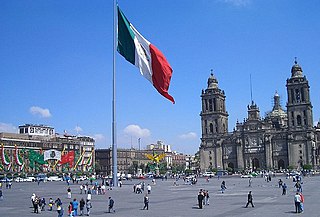
The historic center of Mexico City, also known as the Centro or Centro Histórico, is the central neighborhood in Mexico City, Mexico, focused on Zócalo or main plaza and extending in all directions for a number of blocks, with its farthest extent being west to the Alameda Central. The Zocalo is the largest plaza in Latin America. It can hold up to nearly 100,000 people.

The Torre Latinoamericana is a skyscraper in downtown Mexico City, situated in the historic city center. Its central location, height, and history make it one of the city's most important landmarks. It is widely recognized internationally as an engineering and architectural landmark since it was the world's first major skyscraper successfully built on highly active seismic zone. The skyscraper notably withstood the 8.1 magnitude 1985 Mexico City earthquake without damage, whereas several other structures in the downtown area were damaged.
In the patio of the first cloister, there was a cross that was reputedly taller than the highest tower in the city and made from a cypress tree from the “Chapultepec Forest”, meaning the forested area to the west of the Zocalo, where San Francisco was built. [1]
The church and monastery saw a number of historic events in its time. A funeral mass for Hernán Cortés was here when it was thought that he died in Central America. In 1629, the Marquis of Gelves arrived in disguise to hide after quarreling with the archbishop. In 1692, the Count of Galve and his wife were granted refuge there due to a large-scale rebellion in the city. The end of the Mexican War of Independence was celebrated with a Te Deum at the monastery as the Trigarante Army of 16,000 troops marched past on Madero Street headed by Agustín de Iturbide. [1] After the Reform War, the monastery of San Francisco, like many others, was disbanded and most of the property seized by the government. Much of the old monastery was demolished for the construction of new roads. Other parts of the old building are now a Methodist church facing Gante Street and a Panadería Ideal bakery. [2] Where the bakery is now on 16 de Septiembre Street used to be the De Profundus Room, and the church is housed in the old cloister. On the corner of Venustiano Carranza and Eje Central are what used to be the Calvario and San Antonio chapels. These buildings still exist only because it was more expensive to demolish them than to leave them standing. All that is still left in church hands is the church itself. [2] [1]

DonHernán Cortés de Monroy y Pizarro Altamirano, Marquis of the Valley of Oaxaca was a Spanish Conquistador who led an expedition that caused the fall of the Aztec Empire and brought large portions of what is now mainland Mexico under the rule of the King of Castile in the early 16th century. Cortés was part of the generation of Spanish colonizers who began the first phase of the Spanish colonization of the Americas.
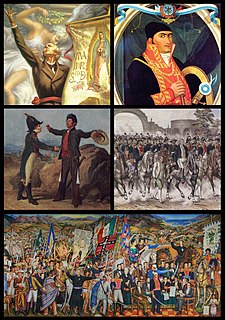
The Mexican War of Independence was an armed conflict, lasting over a decade, which had several distinct phases and took place in different regions of the Spanish colony of New Spain. Events in Spain itself had a direct impact on the outbreak of the insurgency in 1810 and in the alliance of insurgent leader Vicente Guerrero and royalist-officer-turned insurgent Agustín de Iturbide in 1821, which brought about independence. Napoleon Bonaparte's invasion of Spain in 1808 touched off a crisis of legitimacy of crown rule, since he had placed his brother Joseph on the Spanish throne after forcing the abdication of the Spanish monarch Charles IV. In many of Spain's overseas possessions the local response was to set up juntas ruling in the name of the Bourbon monarchy. In New Spain, however, peninsular-born Spaniards overthrew the rule of Viceroy José de Iturrigaray (1803–08). In 1810, a few American-born Spaniards in favor of independence began plotting an uprising against Spanish rule. It occurred when the parish priest of the village of Dolores, Miguel Hidalgo y Costilla, issued the Cry of Dolores on September 16, 1810. The Hidalgo Revolt touched off the armed insurgency for independence, lasting until 1821. The colonial regime did not expect the size and duration of the insurgency, which spread from the Bajío region north of Mexico City to the Pacific and Gulf Coasts. In 1820 when Spanish liberals overthrew the autocratic rule of Ferdinand VII and arch-conservatives in New Spain saw independence as a way to maintain their position, former royalists and old insurgents formed an alliance under the Plan of Iguala and forged the Army of the Three Guarantees. The momentum of independence saw the collapse of royal government in Mexico and the Treaty of Córdoba ended the conflict.

The Te Deum is a Latin Christian hymn composed in the 4th century. It is one of the core hymns of the Ambrosian hymnal, which spread throughout the Latin Church with the Milanese Rite in the 6th to 8th centuries, and is sometimes known as "the Ambrosian Hymn", even though authorship by Saint Ambrose is unlikely.
The church standing today is the third to be built on the site. The first two sunk into the soft soil underneath Mexico City and had to be torn down. [2] This church was built between 1710 and 1716. Although the entire building is known as the San Francisco Church, the entrance on Madero Street is actually the entrance to the Balvanera Chapel. In front of this is an atrium with several sets of stairs leading down to the church building because it, too, is sinking. The church’s main facade, dating from 1710, is walled in and cannot be seen. [2] Entrance is now through the side door into the Balvanera Chapel, then into the main church. [2] The facade of the chapel was constructed in 1766 and it is not sure who constructed it but most think it was the work of Lorenzo Rodríguez, best known for his work on the Metropolitan Tabernacle. The chapel’s statues were removed when the chapel was in the hands of an Evangelical sect, but it kept other decorative elements such as volutes, sculpted leaves and flowers and the estipite (inverted truncated pyramid) columns with medallions. Inside there is an 18th-century altarpiece dedicated to the Virgin of Guadalupe as well as the entrance to what was once the Chapel of the Second Station of the Stations of the Cross. [1]

In architecture, an atrium is a large open air or skylight covered space surrounded by a building. Atria were a common feature in Ancient Roman dwellings, providing light and ventilation to the interior. Modern atria, as developed in the late 19th and 20th centuries, are often several stories high and having a glazed roof or large windows, and often located immediately beyond the main entrance doors.

A volute is a spiral, scroll-like ornament that forms the basis of the Ionic order, found in the capital of the Ionic column. It was later incorporated into Corinthian order and Composite column capitals. Four are normally to be found on an Ionic capital, eight on Composite capitals and smaller versions on the Corinthian capital.
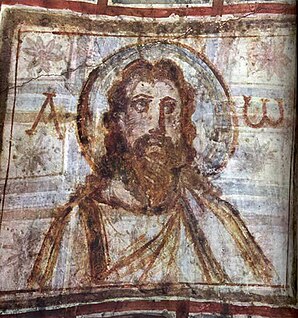
The Stations of the Cross or the Way of the Cross, also known as the Way of Sorrows or the Via Crucis, refers to a series of images depicting Jesus Christ on the day of his crucifixion and accompanying prayers. The stations grew out of imitations of Via Dolorosa in Jerusalem which is believed to be the actual path Jesus walked to Mount Calvary. The object of the stations is to help the Christian faithful to make a spiritual pilgrimage through contemplation of the Passion of Christ. It has become one of the most popular devotions and the stations can be found in many Western Christian churches, including Anglican, Lutheran, Methodist, and Roman Catholic.
In the main church, there is a large gilded main altar, which is one that replaced the original Baroque one. This original one has been reconstructed because Neoclassic artist Jerónimo Antonio Gil left a drawing of it. Only the walls of the original De Profundis Room remain, the rest is remodeled into a bakery. The old cloister on Gante Street has fared a bit better. It is now a Methodist church, where inside both floors of the cloister have been well preserved. It can be visited only with prior authorization. [1]

Neoclassicism is the name given to Western movements in the decorative and visual arts, literature, theatre, music, and architecture that draw inspiration from the "classical" art and culture of classical antiquity. Neoclassicism was born largely thanks to the writings of Johann Joachim Winckelmann, at the time of the rediscovery of Pompeii and Herculaneum, but its popularity spread all over Europe as a generation of European art students finished their Grand Tour and returned from Italy to their home countries with newly rediscovered Greco-Roman ideals. The main Neoclassical movement coincided with the 18th-century Age of Enlightenment, and continued into the early 19th century, laterally competing with Romanticism. In architecture, the style continued throughout the 19th, 20th and up to the 21st century.




